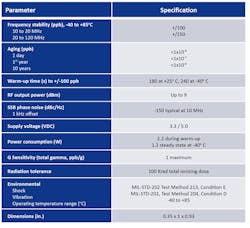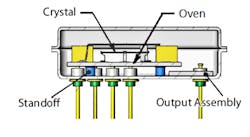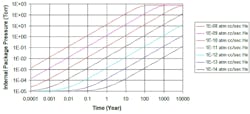The Evacuated Miniaturized Crystal Oscillator: A Step Up for Spaceflight Apps
What you’ll learn:
- Why EMXOs, though less well known than OCXOs, are an appealing alternative for space-system developers.
- How EMXOs help developers maintain the same level of performance as an OCXO in a smaller, lighter package while significantly reducing power consumption.
Space missions expose electronic components to a wide range of harsh environments. Having endured the shock and vibration of launch, components must reliably deliver their rated performance for up to 15 years over wide temperature swings. For crystal oscillators, additional requirements include serving as an extremely precise and stable frequency reference while consuming minimal power in the smallest possible package. This is a tall order that has been filled primarily by the oven-controlled crystal oscillator (OCXO).
However, a more recent class of components—the evacuated miniature crystal oscillator (EMXO)—delivers equal or even better performance and ruggedness in half the size, with less power consumption, along with other advantages. Thus, the EMXO’s increasing popularity should come as no surprise.
Small but Mighty
The quartz crystal employed in a crystal oscillator may seem mundane, but it’s a precision piezoelectric component machined to stringent tolerances. Adjusted to vibrate at a specific frequency, it maintains a high degree of stability owing to its inherently high Q value.
However, crystals are very sensitive to even small changes in temperature that cause their frequency to vary. These variations can be tolerated for some applications, but that’s not the case for many others. The temperature-compensated crystal oscillator (TCXO) was designed to mitigate this problem by adding a temperature-sensitive reactance circuit in its oscillation loop, but the resulting level of improvement may be insufficient for more demanding applications.
A greater-than-tenfold improvement in stability can be realized by placing the crystal in a small oven, thus creating an OCXO. That said, the oven employed in a typical OCXO is a relatively power-hungry device that makes it larger and heavier. This increased power consumption can be a significant problem in spaceflight and other applications in which minimizing size and weight are essential.
The EMXO was created to deliver the same level of performance as an OCXO but in a smaller, lighter, hermetically sealed package while significantly reducing power consumption—key factors in spaceflight applications. Microchip Technology’s EX-219 is a good example of the latest EMXO design with performance characteristics shown in the table.
EX-219 specification parameters for stability, power consumption, and environmental conditions show suitability for spaceflight applications including RF transmitter/receiver, GPS guidance, and reference oscillator.
The development of EMXOs took many years, but the results were well worth the effort. While an OCXO uses insulation of low thermal conductivity to minimize power consumption, an EMXO employs a vacuum as the insulation method. It produces a contamination-free vacuum level of 10-6 torr and reduces insulation weight to virtually nothing. There’s no contamination from weld splashes, dust, or vapor, and this extremely high level of vacuum decreases very little over time. The contamination-free environment also facilitates the use of an open crystal blank rather than a larger packaged type, further reducing size and weight.
As a result, the internal mass of an EMXO can be made smaller than that of a typical OCXO, translating to less volume for the oven to heat as well as lower power consumption. Because the EMXO is evacuated and has much less thermal mass than an OCXO, its warm-up time is much faster. In addition, the crystal blank is integrated within the hybrid package. This contributes to size reduction, enabling the EMXO to be housed in a package less than half the size of a typical OCXO.
The EMXO circuit consists of a heated substrate (oven) and an output substrate. Use of a stress-compensated, doubly rotated crystal (SC/IT-cut) results in good phase noise, a slower aging rate, and lower g‑sensitivity. The crystal has a four-point mounting structure for ruggedness and low g-sensitivity.
Thanks to use of synthetic swept quartz, EMXOs achieve higher radiation tolerance. The thermally insulated structure maintains a nearly constant temperature over its operating temperature range. The output substrate, which doesn’t need to be as thermally isolated, is mounted directly on the case (Fig. 1).
Overcoming EMXO Leak-Rate Test Challenges
Among the many advantages of the EMXO is its leak rate, which is so low (1 × 10-12 atm·cc/s helium) that it’s outside the range of the equipment intended to measure it. The EMXO enclosure is sealed using cold welding, which creates a metallurgical bond between the metal surfaces without adding heat during the sealing process. That said, leakage can be a significant issue with hermetically sealed packages.
Government space agencies require packaged devices to satisfy leakage requirements determined by fine-leak testing. But as the EXMO’s leak rate is lower than what commercial instruments can measure, it’s impossible for an EMXO to be leak-tested using the standard helium-based methods mandated by military specifications for space-borne electronic components. It should be noted that even though the leak rate of an evacuated package isn’t significant while in space, it’s an important consideration while still earthbound.
Hermetic packages are typically sealed using resistance welding or seam welding, and they’re usually backfilled with a mixture of a noble gas and helium as a tracer at a pressure of about 1 atmosphere. This makes it possible to detect a leak rate between 1 × 10-10 and 1 × 10-9 atm·cc/s using commercial instruments with a resolution of 1 × 10-8 atm·cc/s.
Helium bombing is a common technique used to measure leak rates of evacuated enclosures like the EMXO. During this test, a small amount of helium is injected into the sealed package prior to leak testing. However, one drawback is that helium can diffuse and permeate into the metal and glass of the package. During the fine-leak detection process, the helium may be released from the metal or glass, resulting in a pessimistic leak rate. This process is known as desorption and can induce an apparent leak rate of 1 × 10-9 atm·cc/s helium.
Because the oven in the EMXO is proportionally controlled, its power consumption is inversely proportional to the thermal resistance from the oven to the oscillator enclosure. That is, the oven draws current to maintain a nearly constant temperature.
In operation, heat flows from the oven to the case through three heat-transfer mechanisms: convection, conduction, and radiation. Conduction and radiation are influenced by the materials and the construction of the package. Because these are stable properties, they have an insignificant effect on changing the oven current.
As the rate of heat flow through convection in the EMXO is affected by changes in internal package pressure, a leaky unit with higher internal pressure will inherently draw more current. This allows very low leak levels to be detected using simple instruments—if the vacuum degrades due to even a very small leak, power consumption will significantly increase.
Microchip takes advantage of the relationship between power consumption and internal pressure, having developed a high-accuracy process for determining the seal integrity of an EMXO package and enabling it to be qualified for space applications. Analyses have been performed on the EX-209/245 to validate this process.1 The results show that measurements using oven current to measure seal integrity can screen parts with a leak rate of 1 × 10-6, 1 × 10-7, and 1 × 10-8 atm·cc/s helium in minutes, several hours, and a few days after seal, respectively.
The EMXO maintains its stability even when the internal package pressure increases to as high as 1 torr, so it would take up to 70 years for the EMXO’s internal package pressure with a leak rate of 1 × 10-12 atm·cc/s helium to reach a low vacuum of 0.1 torr (Fig. 2). If a 1 × 10-11 atm·cc/sec helium leak rate and 0.5-torr internal package pressure are chosen for a conservative margin of safety, the latest EMXOs can achieve an operating life of 15 years.
Summary
The EMXO may be less well known than its counterparts for use in space, but it offers significant improvements that together make it an appealing alternative. Although the fact that it uses a vacuum as its main differentiator, construction techniques such as cold welding and hybrid construction also significantly contribute to the result. For these reasons, the EMXO has been used in many spaceflight applications for over a decade, and as it gains recognition, it’s likely that many more are in the wings.
Reference
1. “Using Oven Current Instead of Fine Leak Detector to Screen Seal Integrity of EMXO Cold-Weld Evacuated Package,” Hoklay Pak, Microchip Technology, March 2021.



